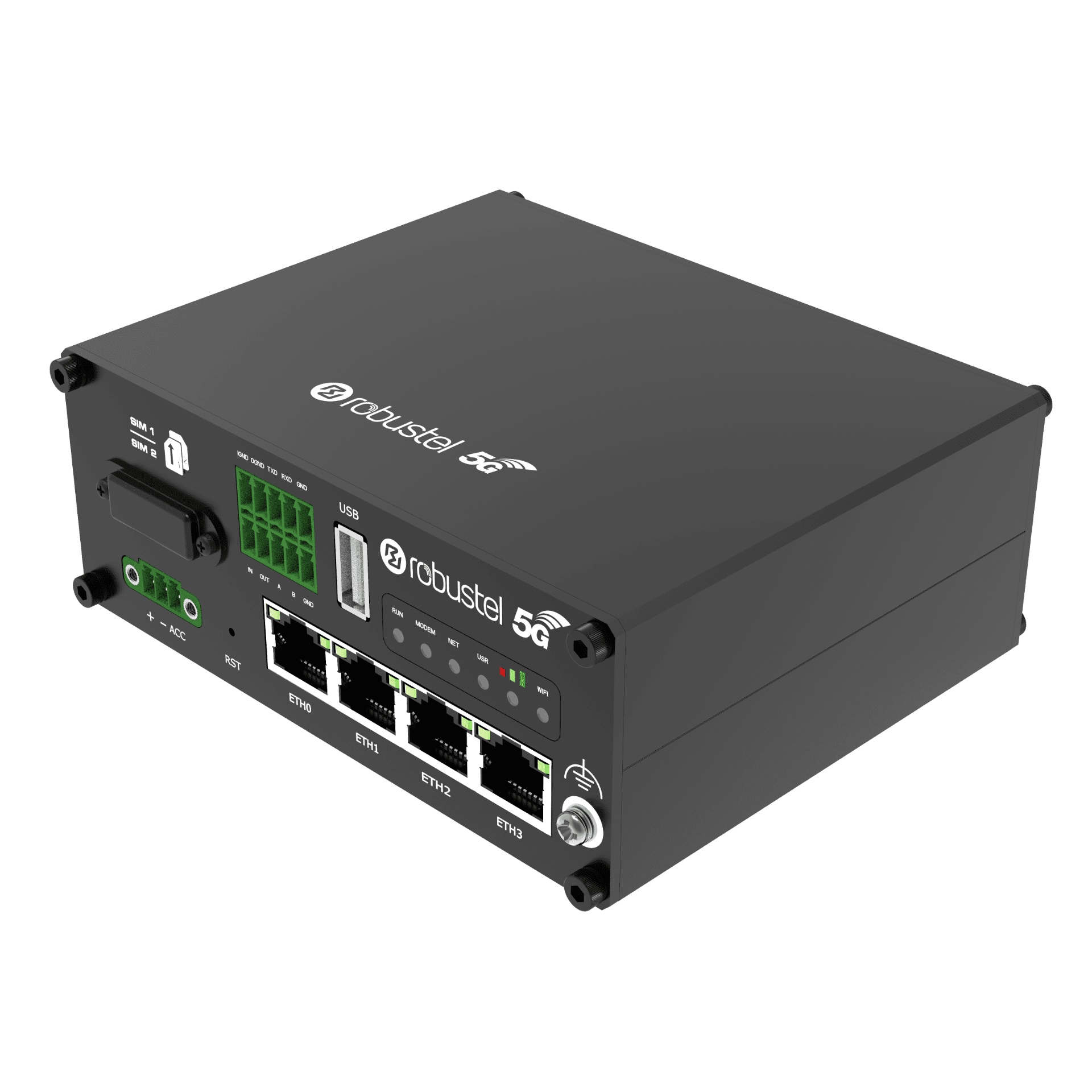Real-Time Monitoring for Mining Trucks and Heavy Mobile Equipment
A Robustel Application Example
Application Example – Fast Facts
Industry
Oil, Gas and Mining, Mining operations / heavy mobile equipment fleets
Product(s)
R5020 5G Router; RCMS (RobustLink, RobustVPN)
Challenges
Haul trucks, water carts, and service vehicles are core to output. Operations wants live location, utilisation, and safety status. Maintenance wants engine health, fault codes, and temperature alerts before a breakdown. The mine needs all of that in near real time, across a harsh site with variable coverage — without pulling logs manually from each truck.
Expected Outcomes
Install a hardened 5G-capable communications unit in every vehicle. Stream operational and diagnostic data back to base while the truck is working, not after the shift. Cut unplanned downtime, improve safety oversight, and give management a live picture of fleet productivity.
In a mine, the fleet is the plant
In processing, you monitor pumps, conveyors, mills. In open pit, your “process plant” is mobile. Your production rate is gated by how consistently trucks move material. If a haul truck goes down in the pit, that’s not just one asset offline it can choke the entire load/haul cycle.
The problem is visibility. Most sites still treat each truck as a black box. You get position from radio checks or a basic GPS ping. You get health data only when the machine returns to the workshop and someone extracts logs. By the time you know there’s an issue (overtemp, brake warning, tyre risk, harsh event), you’re already in recovery mode.
By fitting each critical vehicle with a Robustel R5020 5G Router, wired into onboard systems and managed centrally through RCMS, the mine creates a continuous, high-bandwidth data path from the truck to control. That means operations, maintenance, and safety see what’s happening while it’s happening not after a delay.
Business Challenges
Mining leadership is dealing with a known set of pressures:
- Lost hours = lost tonnage: When a truck is sidelined with a preventable fault, production targets slip. Getting it towed out of the pit is slow, costly, and can create secondary safety exposure. Early warning is not “nice to have.” It’s throughput protection.
- Safety and compliance expectations keep rising: Sites are under pressure to prove that vehicles are being operated safely, inspected on time, and pulled from service when unsafe. That requires traceable data, not post-shift notes.
- Coverage is ugly: Haul routes span benches, dumps, and staging pads. RF conditions change constantly. You need an onboard communications platform that can use high-throughput 5G / LTE where strong, fall back gracefully where weak, and keep buffering/reporting instead of simply going dark.
- Manual data collection doesn’t scale: Walking around with a laptop or USB stick to grab logs off machines might work for three units. It does not work for thirty. It certainly doesn’t work across multiple pits, shifts, or contractors.
- You can’t afford IT complexity in the cab: Whatever you install has to live with vibration, heat, dust, and voltage noise, and it has to “just work” for operators. It can’t be a science project.
Solution Overview
The mine fitted each priority vehicle with a Robustel R5020 5G Router. The R5020 becomes the onboard data and comms hub.
- Built for the environment: The R5020 is designed as an industrial 5G router, not a consumer hotspot. It’s built for high vibration, electrical noise, and temperature swings that would kill office-grade networking hardware. That matters when you mount gear inside the cab of a haul truck or service vehicle that lives in blasting zones, haul roads, and loading stations.
- High-speed, low-latency backhaul from the vehicle: The R5020 supports 5G and high-performance LTE. That bandwidth isn’t just for a GPS ping. It allows richer telemetry, higher reporting frequency, and headroom for future workloads like high-resolution condition data or camera feeds. Even in areas where only LTE is available, the R5020 maintains an uplink so the truck remains visible.
- Direct interface to onboard systems: The R5020 connects to the vehicle’s monitoring/control systems via Ethernet and serial (RS-232 / RS-485). That gives access to real engine/fault data, temperature alarms, brake status, tyre/pressure warnings, utilisation counters — whatever the mine chooses to expose — without having to redesign the OEM controller.
- Encrypted channel back to operations and maintenance: Data leaves the truck in a controlled, encrypted path. Maintenance can see developing issues. Dispatch can see where assets actually are, not where they were 20 minutes ago. Safety can review harsh events or overspeed behaviour with evidence. This is useful both for real-time response and for investigation later.
- Central fleet view in RCMS: All deployed R5020 units report into RCMS. The mine can see which vehicles are online, signal quality, last contact, firmware version, and configuration state. If a unit goes dark unexpectedly, you know immediately. If a router drifts from approved config, you know that too. You’re not flying blind between toolbox talks.
Expected Customer Outcomes
What success looks like for the Operator and the Systems Integration Partner
For the mine operator:
- You see live haul fleet status on shift, not a report tomorrow. That drives faster dispatch decisions and supports production targets.
- You intervene before catastrophic failure. If a truck shows developing high-temp or brake warnings in the pit, you can pull it in a controlled way instead of recovering it dead.
- You build a defensible safety and compliance record. You can show how vehicles were being operated, when alarms were raised, and what actions were taken.
- You reduce wasted maintenance callouts and unplanned recovery work, both of which are expensive and high-risk.
For the integration partner / telemetry provider:
- You deliver something the mine can actually run: a repeatable 5G/LTE telemetry platform that survives the site and scales across fleets.
- You keep ongoing commercial value because you’re not just “install and leave.” You’re providing live visibility that operations and maintenance lean on every day.
- You create a standard package. Same router, same profile, same RCMS view across haul trucks, water carts, fuel/service trucks, and more.
In plain terms: every vehicle becomes a connected production asset, not a moving blind spot.
Featured Products
Robustel R5020 5G Router

RCMS Cloud Device Management

Talk to an Expert
If each haul truck represents real production capacity, then its data is not “nice to have,” it’s critical.
Talk to us about putting a 5G-capable communications core in every high-value vehicle, so you can see issues early, protect output, and run the fleet like the asset base it really is.
